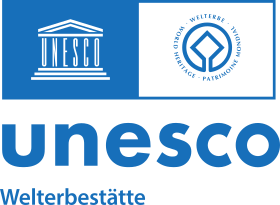Projects of the Klassik Stiftung Weimar are funded by the European Regional Development Fund (ERDF) and the Free State of Thuringia, represented by the State Chancellery of Thuringia, Department of Culture and the Arts.


The floodwaters of 2013 damaged the bridge so severely that by 2016, experts declared the wooden structure no longer safe for visitor traffic. Emergency repairs were carried out that same year. In preparation for the planned replacement of the bridge, building experts conducted extensive historical research and investigations. It was found that the bridge had undergone seven architectural phases since its original construction in 1799. Although its form had changed relatively frequently, it turns out that its nature-like design has been a recurrent theme. Consequently, the Klassik Stiftung Weimar decided to replace of the former white-painted, square-timbered railings with natural log railings in the replacement bridge. The result looks less artificial and allows the bridge – as the wood ages and weathers – to fit in more harmoniously into the forest setting. However, the new bridge is by no means a mere reconstruction, but rather a modern interpretation of a historical design concept.
Compared with its former version, the replacement bridge includes a number of technical innovations. For example, for greater durability, the supporting superstructure contains two (concealed) 14-m long steel-box girders. The wooden planks are made of robust oak and the railings from sapwood-free robinia which is especially resistant to insect infestation. The bridge was constructed in such a way to avoid impacting the historic park, the Ilm River and the nearby vegetation as much as possible. The existing abutments – the foundation upon which the bridge rests on both banks of the river – were reinforced for further use. This enabled builders to forego a larger construction pit which would have damaged the roots of the adjacent trees. In this way, it was possible to preserve a neighbouring Caucasian wingnut and lime tree.
Following the construction of the bridge, landscaping measures restored the surrounding area to appear much like it did in Carl August’s times. The path leading to the Stern was slightly widened and a small clearing was made at the eastern edge, as it once existed before 1855. Moreover, landscapers worked to emphasise the contrast between the western and eastern riverbanks. The western riverbank is characterised by narrow paths winding along the cliffside and densely planted trees. The area was intended to evoke an introverted and melancholy mood, especially in combination with the neighbouring Bark Hut and cliff stairway. But as visitors cross the bridge to the east, they encounter a spacious landscape of bright, sunny Ilm meadows. The Goethe Gartenhaus appears in the background, framed by individual trees in the foreground. This demonstrates how the park was intentionally designed as a walkable total artwork capable of evoking various moods and atmospheres. With the construction of the refurbished bridge and the surrounding area, the Park on the Ilm is once again complete.
The project was financed through the “Construction Assistance Programme for Removing Damage Caused by the Floodwaters from 18 May to 9 July 2013 in Thuringia for Cultural Organisations and Cultural Monuments Irrespective of their Funding Bodies”.


Building, civil and structural engineering planning: Marx Krontal Partner GmbH, Weimar/Hannover
Landscaping: Landschaftsarchitekturbüro von Gagern, Dresden
Monument preservation objective: Landschaftsarchitekten Jenny Pfriem, Coswig
Subsoil report: Geotechnik Dr. Nottrodt, Weimar
Hydraulic calculation and drag tension verification: Köhler Ingenieurgesellschaft, Bad Steben
Surveying work: B.A.U.WERK, Weimar
SiGeKo: SIMEBU Thüringen GmbH, Weimar